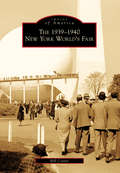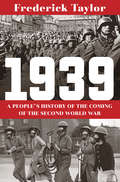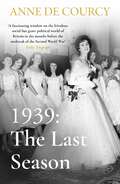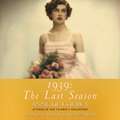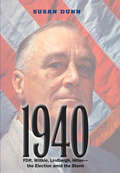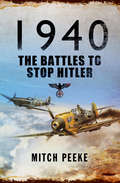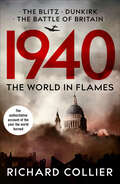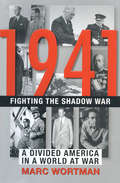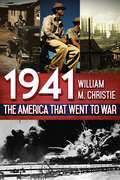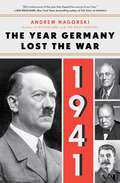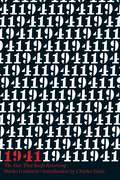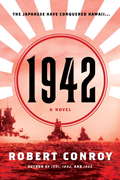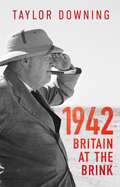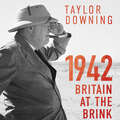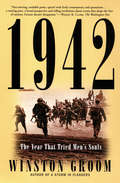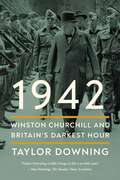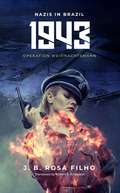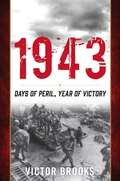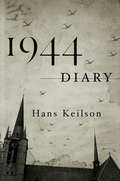- Table View
- List View
1939-1940 New York World's Fair, The
by Bill CotterAfter enduring 10 harrowing years of the Great Depression, visitors to the 1939-1940 New York World's Fair found welcome relief in the fair's optimistic presentation of the "World of Tomorrow." Pavilions from America's largest corporations and dozens of countries were spread across a 1,216-acre site, showcasing the latest industrial marvels and predictions for the future intermingled with cultural displays from around the world. Well known for its theme structures, the Trylon and Perisphere, the fair was an intriguing mixture of technology, science, architecture, showmanship, and politics. Proclaimed by many as the most memorable world's fair ever held, it predicted wonderful times were ahead for the world even as the clouds of war were gathering. Through vintage photographs, most never published before, The 1939-1940 New York World's Fair recaptures those days when the eyes of the world were on New York and on the future.
1939: A People's History Of The Coming Of The Second World War
by Frederick TaylorA best-selling historian’s chronicle of the dramatic months from the Munich Agreement to Hitler’s invasion of Poland and the beginning of World War II. In the autumn of 1938, Europe believed in the promise of peace. But only a year later, the fateful decisions of just a few men had again led Europe to a massive world war. Drawing on contemporary diaries, memoirs, and newspapers, as well as recorded interviews, 1939 is a narrative account of what the coming of the Second World War felt like to those who lived through it. Frederick Taylor, author of renowned histories of the Berlin Wall and the bombing of Dresden, highlights the day-to-day experiences of ordinary citizens as well as those who were at the height of power in Germany and Britain. Their voices lend an intimate flavor to this often-surprising account of the period and reveal a marked disconnect between government and people, for few people in either country wanted war. 1939 is a vivid and richly peopled narrative of Europe’s slide into the horrors of war and a powerful warning for our own time.
1939: The Last Season
by Anne de CourcyA wonderful portrait of British upper-class life in the Season of 1939 - the last before the Second World War.The Season of 1939 brought all those 'in Society' to London. The young debutante daughters of the upper classes were presented to the King and Queen to mark their acceptance into the new adult world of their parents. They sparkled their way through a succession of balls and parties and sporting events.The Season brought together influential people not only from Society but also from Government at the various events of the social calendar. Prime Minister Neville Chamberlain chaperoned his debutante niece to weekend house parties; Lord Halifax, the Foreign Secretary, lunched with the Headmaster of Eton; Cabinet Ministers encountered foreign Ambassadors at balls in the houses of the great hostesses. As the hot summer drew on, the newspapers filled with ever more ominous reports of the relentless progress towards war. There was nothing to do but wait - and dance. The last season of peace was nearly over.
1939: The Last Season
by Anne de CourcyA wonderful portrait of British upper-class life in the Season of 1939 - the last before the Second World War.The Season of 1939 brought all those 'in Society' to London. The young debutante daughters of the upper classes were presented to the King and Queen to mark their acceptance into the new adult world of their parents. They sparkled their way through a succession of balls and parties and sporting events.The Season brought together influential people not only from Society but also from Government at the various events of the social calendar. Prime Minister Neville Chamberlain chaperoned his debutante niece to weekend house parties; Lord Halifax, the Foreign Secretary, lunched with the Headmaster of Eton; Cabinet Ministers encountered foreign Ambassadors at balls in the houses of the great hostesses. As the hot summer drew on, the newspapers filled with ever more ominous reports of the relentless progress towards war. There was nothing to do but wait - and dance. The last season of peace was nearly over.
1939: The Last Season
by Anne de CourcyA wonderful portrait of British upper-class life in the Season of 1939 - the last before the Second World War.The Season of 1939 brought all those 'in Society' to London. The young debutante daughters of the upper classes were presented to the King and Queen to mark their acceptance into the new adult world of their parents. They sparkled their way through a succession of balls and parties and sporting events.The Season brought together influential people not only from Society but also from Government at the various events of the social calendar. Prime Minister Neville Chamberlain chaperoned his debutante niece to weekend house parties; Lord Halifax, the Foreign Secretary, lunched with the Headmaster of Eton; Cabinet Ministers encountered foreign Ambassadors at balls in the houses of the great hostesses. As the hot summer drew on, the newspapers filled with ever more ominous reports of the relentless progress towards war. There was nothing to do but wait - and dance. The last season of peace was nearly over.
194 High-Impact Letters for Busy Principals: A Guide to Handling Difficult Correspondence
by Dr Marilyn L. GradyThis expanded collection of letters is truly a time-saving starter kit, providing busy principals with easy-to-personalize templates on a PC- and Mac-compatible CD-ROM to revitalize your communications repertoire.
1940: FDR, Willkie, Lindbergh, Hitler—the Election amid the Storm
by Susan DunnA history of the 1940 U.S. presidential election, when bitterly divided Americans debated the fate of the nation and the world. In 1940, against the explosive backdrop of the Nazi onslaught in Europe, two farsighted candidates for the U.S. presidency—Democrat Franklin D. Roosevelt, running for an unprecedented third term, and talented Republican businessman Wendell Willkie—found themselves on the defensive against American isolationists and their charismatic spokesman Charles Lindbergh, who called for surrender to Hitler's demands. In this dramatic account of that turbulent and consequential election, historian Susan Dunn brings to life the debates, the high-powered players, and the dawning awareness of the Nazi threat as the presidential candidates engaged in their own battle for supremacy. 1940 not only explores the contest between FDR and Willkie but also examines the key preparations for war that went forward, even in the midst of that divisive election season. The book tells an inspiring story of the triumph of American democracy in a world reeling from fascist barbarism, and it offers a compelling alternative scenario to today&’s hyperpartisan political arena, where common ground seems unattainable. &“Anyone today who believes that U.S. involvement and the ultimate Allied triumph in World War II was inevitable must read this important history."—Michael Beschloss, New York Times bestselling author of Presidential Courage &“Susan Dunn, a prolific and outstanding historian, has crafted a fast-paced, serious, and extraordinarily well-researched book about the events surrounding the pivotal 1940 election. Her main characters…come brilliantly to life. I could hardly put the book down.&”—James T. Patterson, author of Bancroft Prize-winning Grand Expectations: The United States, 1945-1974
1940: The Battles to Stop Hitler
by Mitch PeekeThe story of one momentous year in World War II. The epic story of 1940 is not confined to the great air battle over England that summer, the Battle of Britain. While that battle was indeed a major turning point in the course of the Second World War, it was only fought because of the ultimate outcome of the battle that preceded it. When Hitler&’s forces swiftly overran the Low Countries and then France, the remnants of the French and British armies were trapped in a pocketed position around the channel port of Dunquerque. Militarily, that should have been the end of it. Trapped with their backs to the sea, the tired soldiers surely faced annihilation or capture. Hitler&’s generals certainly thought so. But then Hitler made his first and biggest mistake. He listened to his old friend and commander of the German Air Force, Herman Goering. Instead of allowing his armies to finish the job, he ordered them to halt. Goering had persuaded his Fuhrer to allow his Air Force to finish it instead. Goering failed, giving the British time to evacuate the stranded armies from Dunqerque. The Battle of France was over, but there would have to be a Battle of Britain, as Britain would now have to be eliminated as well, either by diplomacy, which wasn&’t likely, or by invasion. This was the prospect facing those in England at that time—and this is the story of that momentous year.
1940: The World in Flames (The Second World War Histories)
by Richard CollierThe most shocking year in history. Week by week, hour by hour.In his brilliant reconstruction, Richard Collier vividly brings one of the most momentous years in world history to life once again.This was a time of blitzkrieg and the Blitz; of the Battle of Britain and Dunkirk. From the fighting in Finland to the destruction of Coventry, from the sinking of the French fleet in Oran to the invasion of Norway, this is history at its most extraordinary and engaging.By recounting major episodes from the viewpoint of those actually involved, Collier provides enlightening glimpses of just what war represented to both the great and to the unknown, and reveals that while 1940 was a year of incredible folly, it was also a time of inestimable bravery.Perfect for readers of Anthony Beevor and Max Hastings, this is an unforgettable book about an unforgettable year, a year that shaped the world we know today.‘Masterly… you could be reading a spine-tingling thriller’ Sunday Express‘I would like to see this book made compulsory reading’ Evening Standard
1941 -- The Greatest Year In Sports
by Mike VaccaroJoe DiMaggio . . . Ted Williams . . . Joe Louis . . . Billy Conn . . . WhirlawayAgainst the backdrop of a war that threatened to consume the world, these athletes transformed 1941 into one of the most thrilling years in sports history.In the summer of 1941, America paid attention to sports with an intensity that had never been seen before. World War II was raging in Europe and headlines grew worse by the day; even the most optimistic people began to accept the inevitability of the United States being drawn into the conflict. In sports pages and arenas at home, however, an athletic perfect storm provided unexpected--and uplifting--relief. Four phenomenal sporting events were underway, each destined to become legend.In 1941--The Greatest Year in Sports, acclaimed sportswriter Mike Vaccaro chronicles this astounding moment in history. Fueled by a somber mania for sports--a desire for good news to drown out the bad--Americans by the millions fervently watched, listened, and read as Joe DiMaggio dazzled the country by hitting in a record-setting fifty-six consecutive games; Ted Williams powered through an unprecedented .406 season; Joe Louis and Billy Conn (the heavyweight and light-heavyweight champions) battled in unheard-of fashion for boxing's ultimate championship; and the phenomenal (some say deranged) thoroughbred, Whirlaway, raced to three heart-stopping victories that won the coveted Triple Crown of horse racing. As Phil Rizzuto perfectly expressed, "You read the sports section a lot because you were afraid of what you'd see in other parts of the paper."Gripping and nostalgic, 1941--The Greatest Year in Sports focuses on these four seminal events and brings to life the national excitement and remarkable achievement (many of these records still stand today), as well as the vibrant lives of the athletes who captivated the nation. With vast insight, Vaccaro pulls back the veil on DiMaggio's anxieties and the building pressure of "The Streak," and chronicles the brash, young confidence Williams displayed as he hammered his way through the baseball season largely in DiMaggio's shadow. He takes readers inside the head of Billy Conn, a kid who traded in his light-heavyweight belt for a shot at the very decent and very powerful Joe Louis, and tells the story of the fire-breathing racehorse, Whirlaway, who was known either for setting track records or tearing off in the wrong direction. Rich in historical detail and edge-of-your-seat reporting, Mike Vaccaro has crafted a lasting, important book that captures a portrait of one of America's most trying, and extraordinary, eras.From the Trade Paperback edition.
1941: Armageddon (The Second World War Histories)
by Richard CollierOne of the greatest and most terrible years in world history.‘This war has now assumed the character’, wrote Benito Mussolini, before 1941 was six months old, ‘of a war between two worlds’, and the Italian dictator had rarely predicted more truly.Before the year had ended, following Hitler’s surprise assault on Russia and the Japanese attack on Pearl Harbor, thirty-seven nations were engaged in an all-out war reminiscent of Armageddon, ‘the battle of that great day of God Almighty’.Richard Collier’s latest narrative spans both this entire, devastating year, as well as the events that led up to it. From the hunting of the Bismarck through the North Atlantic to the triumphs of Rommel’s Afrika Korps, from the horror and heroism of besieged Leningrad to the debacles of Hong Kong, Malaya and the Far East, this is a panorama of truly world-wide proportions.An unputdownable narrative of the most extraordinary year in world history, perfect for readers of Max Hastings, James Holland and Antony Beevor.
1941: Fighting the Shadow War: A Divided America in a World at War
by Marc WortmanIn 1941: Fighting the Shadow War, A Divided America in a World at War, historian Marc Wortman thrillingly explores the little-known history of America’s clandestine involvement in World War II before the attack on Pearl Harbor.Prior to that infamous day, America had long been involved in a shadow war. Winston Churchill, England’s beleaguered new Prime Minister, pleaded with Franklin D. Roosevelt for help. FDR concocted ingenious ways to come to his aid, without breaking the Neutrality Acts. Launching Lend-Lease, conducting espionage at home and in South America to root out Nazi sympathizers, and waging undeclared war in the Atlantic, were just some of the tactics with which FDR battled Hitler in the shadows.FDR also had to contend with growing isolationism and anti-Semitism as he tried to influence public opinion. While Americans were sympathetic to those being crushed under Axis power, they were unwilling to enter a foreign war. Wortman tells the story through the eyes of the powerful as well as ordinary citizens. Their stories weave throughout the intricate tapestry of events that unfold during the crucial year of 1941.Combining military and political history, Wortman tells the eye-opening story of how FDR took the country to war.
1941: The America That Went to War
by William M. ChristieA panoramic and intimate portrait of America and its people in the twelve months leading up to its entry into WWII. From Joe DiMaggio’s still unbroken hitting streak to the infamy of Pearl Harbor, 1941: The America That Went to War immerses readers in a world of big bands and bigger headlines.The America of 1941 was very different from the country we know today. Most people were just getting back on their feet after the struggles of the Depression. Access to the political process was uneven, ethnic stereotypes were widely accepted, and concerns with social justice were only beginning to expand.After the Depression, most workers found jobs related to the growing defense industry, but the nation was fearful of the foreign wars that made increased armaments necessary. Yet everything was about to change with the forced entry onto the world stage. Christie describes all this and more, demonstrating that one cannot understand the United States during and after World War II without understanding the country that entered the war.Organized in a series of vignettes representing focal events of each month, 1941 show both what Americans were doing and how they saw themselves and the world in that last year of peace.“A fascinating glimpse of a country passing through the twilight of splendid isolation to becoming a world power.” —The New York Journal of Books
1941: The Year Germany Lost the War
by Andrew NagorskiBestselling historian Andrew Nagorski &“brings keen psychological insights into the world leaders involved&” (Booklist) during 1941, the critical year in World War II when Hitler&’s miscalculations and policy of terror propelled Churchill, FDR, and Stalin into a powerful new alliance that defeated Nazi Germany. In early 1941, Hitler&’s armies ruled most of Europe. Churchill&’s Britain was an isolated holdout against the Nazi tide, but German bombers were attacking its cities and German U-boats were attacking its ships. Stalin was observing the terms of the Nazi-Soviet Pact, and Roosevelt was vowing to keep the United States out of the war. Hitler was confident that his aim of total victory was within reach. But by the end of 1941, all that changed. Hitler had repeatedly gambled on escalation and lost: by invading the Soviet Union and committing a series of disastrous military blunders; by making mass murder and terror his weapons of choice, and by rushing to declare war on the United States after Japan&’s attack on Pearl Harbor. Britain emerged with two powerful new allies—Russia and the United States. By then, Germany was doomed to defeat. Nagorski illuminates the actions of the major characters of this pivotal year as never before. 1941: The Year Germany Lost the War is a stunning and &“entertaining&” (The Wall Street Journal) examination of unbridled megalomania versus determined leadership. It also reveals how 1941 set the Holocaust in motion, and presaged the postwar division of Europe, triggering the Cold War. 1941 was &“the year that shaped not only the conflict of the hour but the course of our lives—even now&” (New York Times bestselling author Jon Meacham).
1941: The Year That Keeps Returning
by Charles Simic Michael Gable Slavko GoldsteinA New York Review Books OriginalThe distinguished Croatian journalist and publisher Slavko Goldstein says, "Writing this book about my family, I have tried not to separate what happened to us from the fates of many other people and of an entire country." 1941: The Year That Keeps Returning is Goldstein's astonishing historical memoir of that fateful year--when the Ustasha, the pro-fascist nationalists, were brought to power in Croatia by the Nazi occupiers of Yugoslavia. On April 10, when the German troops marched into Zagreb, the Croatian capital, they were greeted as liberators by the Croats. Three days later, Ante Pavelić, the future leader of the Independent State of Croatia, returned from exile in Italy and Goldstein's father, the proprietor of a leftist bookstore in Karlovac--a beautiful old city fifty miles from the capital--was arrested along with other local Serbs, communists, and Yugoslav sympathizers. Goldstein was only thirteen years old, and he would never see his father again. More than fifty years later, Goldstein seeks to piece together the facts of his father's last days. The moving narrative threads stories of family, friends, and other ordinary people who lived through those dark times together with personal memories and an impressive depth of carefully researched historic details. The other central figure in Goldstein's heartrending tale is his mother--a strong, resourceful woman who understands how to act decisively in a time of terror in order to keep her family alive. From 1941 through 1945 some 32,000 Jews, 40,000 Gypsies, and 350,000 Serbs were slaughtered in Croatia. It is a period in history that is often forgotten, purged, or erased from the history books, which makes Goldstein's vivid, carefully balanced account so important for us today--for the same atrocities returned to Croatia and Bosnia in the 1990s. And yet Goldstein's story isn't confined by geographical boundaries as it speaks to the dangers and madness of ethnic hatred all over the world and the urgent need for mutual understanding.
1942: A Novel
by Robert ConroyDecember 7 is "the date which will live in infamy." But now Japan is hatching another, far greater plan to bring America to its knees. . . . The Japanese surprise attack on Pearl Harbor was a resounding success-except for one detail: a second bombing mission, to destroy crucial oil storage facilities, was aborted that day. Now, in this gripping and stunning work of alternate history, Robert Conroy reimagines December 7, 1941, to include the attack the Japanese didn't launch, and what follows is a thrilling tale of war, resistance, sacrifice, and courage. For when Admiral Isoroku Yamamoto sees how badly the United States has been ravaged in a two-pronged strike, he devises another, more daring proposal: an all-out invasion of Hawaii to put a stranglehold on the American Pacific Fleet. Yamamoto's strategy works brilliantly-at first. But a handful of American soldiers and a determined civilian resistance fight back in the face of cruelty unknown in Western warfare. Stateside, a counterassault is planned-and the pioneering MIT-trained aviator Colonel Jimmy Doolittle is given a near-impossible mission with a fleet of seaplanes jury-rigged into bombers. From spies to ordinary heroes and those caught between two cultures at war, this is the epic saga of the Battle of Hawaii-the way it very nearly was. . . .
1942: Britain at the Brink
by Taylor Downing'Taylor Downing vividly brings to life a terrible year' Max Hastings Sunday TimesEighty years ago, Britain stood at the brink of defeat. In 1942, a string of military disasters engulfed Britain in rapid succession : the collapse in Malaya; the biggest surrender in British history at Singapore; the passing of three large German warships through the Straits of Dover in broad daylight; the longest ever retreat through Burma to the gates of India; serious losses to Rommel's forces in North Africa; the siege of Malta and the surrender at Tobruk. All of this occurred against the backdrop of catastrophic sinkings in the Atlantic and the Arctic convoys. People began to claim that Churchill was not up to the job and his leadership was failing badly. Public morale reached a new low. 1942 Britain At the Brink explores the story of frustration and despair in that year prompting the Prime Minister to demand of his army chief 'Have you not got a single general who can win battles?' Using new archival material, historian Taylor Downing shows just how unpopular Churchill became in 1942 with two votes attacking his leadership in the Commons and the emergence of a serious political rival. Most people think that Britain's worst moment of the war was in 1940 when the nation stood up against the threat of German invasion. In 1942 Britain at the Brink, Taylor Downing describes in nail-biting detail what was really Britain's darkest hour .
1942: Britain at the Brink
by Taylor Downing'Taylor Downing vividly brings to life a terrible year' Max Hastings Sunday TimesEighty years ago, Britain stood at the brink of defeat. In 1942, a string of military disasters engulfed Britain in rapid succession : the collapse in Malaya; the biggest surrender in British history at Singapore; the passing of three large German warships through the Straits of Dover in broad daylight; the longest ever retreat through Burma to the gates of India; serious losses to Rommel's forces in North Africa; the siege of Malta and the surrender at Tobruk. All of this occurred against the backdrop of catastrophic sinkings in the Atlantic and the Arctic convoys. People began to claim that Churchill was not up to the job and his leadership was failing badly. Public morale reached a new low. 1942 Britain At the Brink explores the story of frustration and despair in that year prompting the Prime Minister to demand of his army chief 'Have you not got a single general who can win battles?' Using new archival material, historian Taylor Downing shows just how unpopular Churchill became in 1942 with two votes attacking his leadership in the Commons and the emergence of a serious political rival. Most people think that Britain's worst moment of the war was in 1940 when the nation stood up against the threat of German invasion. In 1942 Britain at the Brink, Taylor Downing describes in nail-biting detail what was really Britain's darkest hour .
1942: Britain at the Brink
by Taylor Downing'Taylor Downing vividly brings to life a terrible year' Max Hastings, Sunday Times'Taylor Downing is a wonderful historian and a wonderful history communicator.' Dan Snow, History HitEighty years ago, Britain stood at the brink of defeat. In 1942, a string of military disasters engulfed Britain in rapid succession : the collapse in Malaya; the biggest surrender in British history at Singapore; the passing of three large German warships through the Straits of Dover in broad daylight; the longest ever retreat through Burma to the gates of India; serious losses to Rommel's forces in North Africa; the siege of Malta and the surrender at Tobruk. All of this occurred against the backdrop of catastrophic sinkings in the Atlantic and the Arctic convoys. People began to claim that Churchill was not up to the job and his leadership was failing badly. Public morale reached a new low. 1942 Britain At the Brink explores the story of frustration and despair in that year prompting the Prime Minister to demand of his army chief 'Have you not got a single general who can win battles?' Using new archival material, historian Taylor Downing shows just how unpopular Churchill became in 1942 with two votes attacking his leadership in the Commons and the emergence of a serious political rival. Most people think that Britain's worst moment of the war was in 1940 when the nation stood up against the threat of German invasion. In 1942 Britain at the Brink, Taylor Downing describes in nail-biting detail what was really Britain's darkest hour .
1942: The Year That Tried Men's Souls
by Winston GroomAmerica’s first year in World War II, chronicled in this “page-turner” by the Pulitzer Prize–nominated author of Forrest Gump and The Generals (Publishers Weekly). On December 7, 1941, an unexpected attack on American territory pulled an unprepared country into a terrifying new brand of warfare. To the generation of Americans who lived through it, the Second World War was the defining event of the twentieth century, and the defining moments of that war were played out in the year 1942. This account covers the Allies’ relentless defeats as the Axis overran most of Europe, North Africa, and the Far East. But by midyear the tide began to turn. The United States finally went on the offensive in the Pacific. In the West, the British defeated Rommel’s panzer divisions at El Alamein while the US Army began to push the Germans out of North Africa. By the year’s end, the smell of victory was in the air. 1942, told with Winston Groom’s accomplished storyteller’s eye, allows us into the admirals’ strategy rooms, onto the battlefronts, and into the heart of a nation at war. “When not drawing in readers with the narrative, Groom is impressing them with his masterful analyses.” —The Atlanta Journal-Constitution “Groom has done an artful job of blending the many stories of 1942.” —The Anniston Star
1942: When World War II Engulfed the Globe
by Peter FritzscheA penetrating history of the year World War II became a global conflict and humankind confronted both destruction and deliverance on a planetary scale, &“offering an intriguing perspective on a world at war&” (Richard Overy, New York Times–bestselling author of Blood and Ruins) By the end of the Second World War, more than seventy million people across the globe had been killed, most of them civilians. Cities from Warsaw to Tokyo lay in ruins, and fully half of the world&’s two billion people had been mobilized, enslaved, or displaced. In 1942, historian Peter Fritzsche offers a gripping, ground-level portrait of the decisive year when World War II escalated to global catastrophe. With the United States joining the fight following Japan&’s attack on Pearl Harbor, all the world&’s great powers were at war. The debris of ships sunk by Nazi submarines littered US beaches, Germans marauded in North Africa, and the Japanese swept through the Pacific. Military battles from Singapore to Stalingrad riveted the world. But so, too, did dramas on the war&’s home fronts: battles against colonial overlords, assaults on internal &“enemies,&” massive labor migrations, endless columns of refugees. With an eye for detail and an eye on the big story, Fritzsche takes us from shipyards on San Francisco Bay to townships in Johannesburg to street corners in Calcutta to reveal the moral and existential drama of a people&’s war filled with promise and terror.
1942: Winston Churchill and Britain's Darkest Hour
by Taylor DowningA revelatory new work of popular history focused on the year 1942, as the fate of Britain—and Winston Churchill&’s leadership—hangs in the balance.Eighty years ago, Britain stood at the brink of defeat. In 1942, a string of military disasters engulfed Britain in rapid succession : the collapse in Malaya; the biggest surrender in British history at Singapore; the passing of three large German warships through the Straits of Dover in broad daylight; the longest ever retreat through Burma to the gates of India; serious losses to Rommel's forces in North Africa; the siege of Malta and the surrender at Tobruk. All of this occurred against the backdrop of catastrophic sinkings in the Atlantic and the Arctic convoys. People began to claim that Churchill was not up to the job and his leadership was failing badly. Public morale reached a new low. Taylor Downing&’s 1942 explores the story of frustration and despair of that year, prompting Winston Churchill to demand of his army chief, "Have you not got a single general who can win battles?&” Using newly discovered archival material, historian Taylor Downing shows just how unpopular Churchill became in 1942, with two votes attacking his leadership in the House of Commons and the emergence of a serious political rival.Some argue that Britain's most precarious moment of the war was in 1940—when the nation stood up against the threat of German invasion during the Battle of Britain. But in 1942, Taylor Downing describes, in nail-biting detail, what was really Britain's darkest hour of World War II.
1943 -- Operation Weihnachtsmann: Nazis in Brazil
by Jb Rosa FilhoSuspenseful novel about attempts of Nazi Abwehr agent to subvert Brazil's valiant efforts in support of the Allied war effort during World War Two -- a little known and much neglected theater of that critically important event.
1943: Days of Peril, Year of Victory
by Victor BrooksMilitary historian Victor Brooks argues that the year 1943 marked a significant shift in the World War II balance of power from the Axis to Allied forces. Brooks presents a global narrative of the American experience of war during the year, ranging from the tiny blood-drenched island of Tarawa to the vast expanses of North Africa. At no other period was the course of the war in such precarious balance, the author argues, as both Axis and Allies possessed roughly equivalent power, and as both sides still had reasonable expectations that victory could be achieved.At the beginning of 1943, the tide was slowly turning for the Americans and their allies, Still, the shame of terrible defeats on Bataan and in the Java Sea, at Dieppe and Savo Island were very recent memories. Early on, Americans had high hopes for a massive improvement in the direction of the war; by the end of the year, those hopes were becoming realities. The year 1943 is also the period in which the titans of the war were just emerging. Douglas MacArthur, Dwight Eisenhower, Chester Nimitz, William Halsey, George Patton, Holland Smith and other iconic leaders had begun surfacing as household names in 1943 and would form a nucleus of the command structure that shattered the Axis in 1944 and 1945.In 1943, Brooks presents the history of the year when some of the most exciting and important moments occurred on the road to Allied victory.
1944 Diary
by Damion Searls Hans Keilson[1944 Diary] is a deeply personal account, made even more remarkable that it was written during World War II and the horrors of the Holocaust . . . A moving and fascinating read." —Library JournalIn 2010, FSG published two novels by the German- Jewish writer Hans Keilson: Comedy in a Minor Key—written in 1944 while Keilson was in hiding in the Netherlands, first published in German in 1947, and never before in English—and The Death of the Adversary, begun in 1944 and published in 1959, also in German. With their Chekhovian sympathy for perpetrators and bystanders as well as for victims and resisters, Keilson’s novels were, as Francine Prose said on the front page of The New York Times Book Review, “masterpieces” by “a genius” on her list of “the world’s very greatest writers.” Keilson was one hundred years old, alive and well and able to enjoy his belated fame.1944 Diary, rediscovered among Keilson’s papers shortly after his death, covers nine months he spent in hiding in Delft with members of a Dutch resistance group, having an affair with a younger Jewish woman in hiding a few blocks away and striving to make a moral and artistic life for himself as the war and the Holocaust raged around him. For readers familiar with Keilson’s novels as well as those new to his work, this diary is an incomparable spiritual X-ray of the mind and heart behind the art: a record of survival and creativity in what Keilson called “the most critical year of my life.”Offering further insight into Keilson are the sonnets he wrote for his lover, Hanna Sanders, which appear in translation at the back of this volume.
